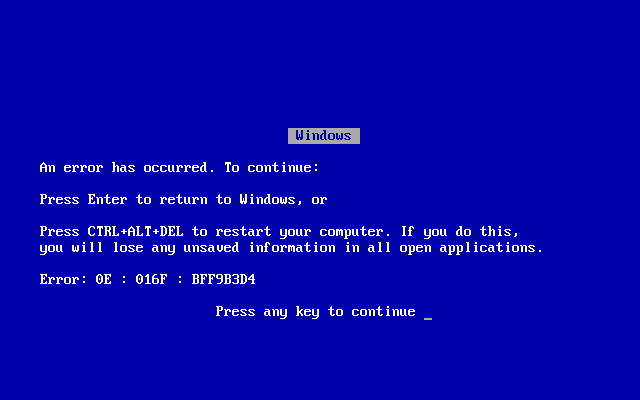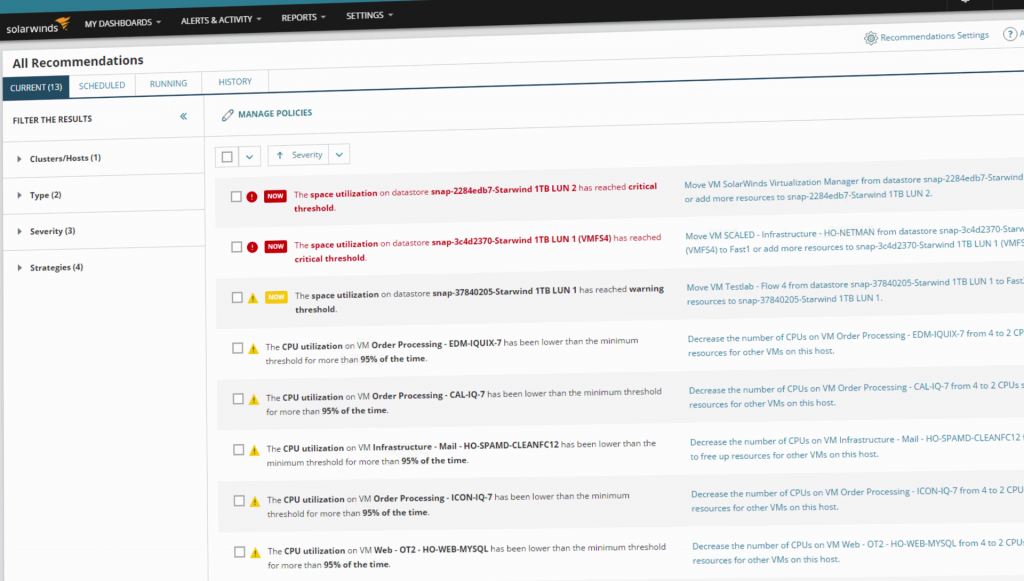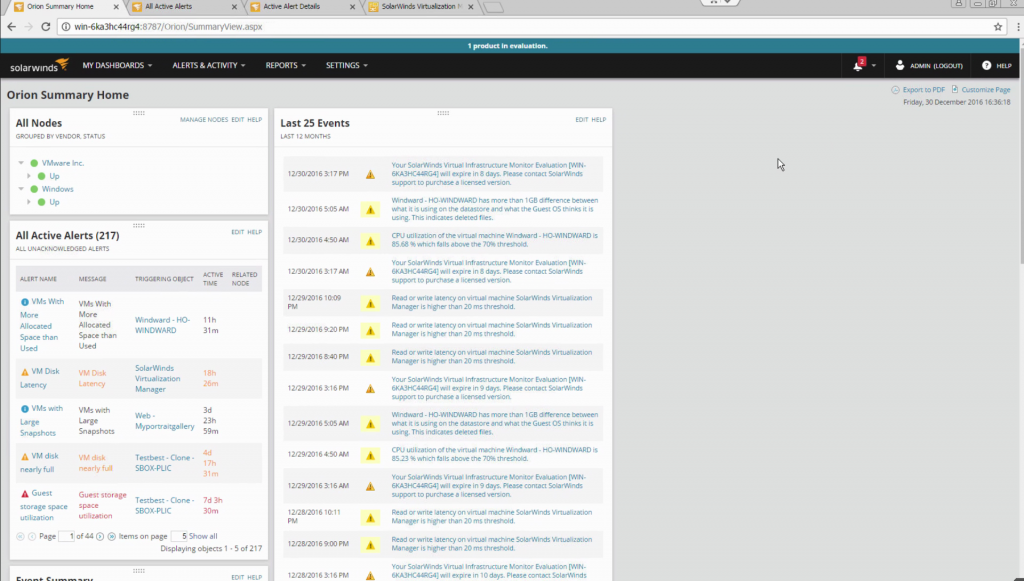Information Overload? There’s an app for that.
Solarwinds Virtualization Manager tells you what you need to know, when you need to know it.
Computers are the most awful way to do things, except for all the other ways we’ve tried. It’s easy to blame computers; they don’t fight back. What’s much more difficult, yet distressingly important, is figuring out why computers have done something unappreciated and remedying the situation. One important tool in a systems administrator’s arsenal is Solarwinds’ Virtualization Manager.
Humans have a natural tendency to anthropomorphize inanimate objects. Many of us give our cars names, ascribe to them personalities, talk to them and sometimes treat them like members of the family. We similarly ascribe personalities and motivations to individual computers or even entire networks of them, often despite being perfectly aware of the irrationality of this. We can’t help it: anthropomorphizing is part of being human.
Computers, however, aren’t human. They don’t have motives and they don’t act without input. They do exactly they are told, and that’s usually the problem. The people telling the computers what to do – be they end users or systems administrators – are fallible. The weakest link is always that which exists between keyboard and chair.
Our likelihood of making an error increases the more stress we’re put under. Whether due to unreasonable demand, impossible deadlines, or networks which have simply grown too large to keep all the moving parts in our memory at given time, we fallible humans need the right tools to do the job well.
You wouldn’t ask a builder to build you a home using slivers of metal and a rock to hammer them. So why is it that we so frequently expect systems administrators to maintain increasingly complex networks with the digital equivalent of two rocks to bash together? It’s a terrible prejudice that leads many organizations to digital ruin. A tragedy that, in many cases, is easily avoided.

Information overload
We live in an era of information overload. All too many of us wake up, preform our morning ablutions and then pull out our smartphones. As with generations prior, our mornings consist of making choices about what to wear, what to have for breakfast and then making sure all family members know one another’s schedules.
What’s changed today is that we then dive into our phones for social media, our work schedules, e-mail, and – if you’re a systems administrator – the helpdesk system. This is a problem. Information overload leads to decision fatigue. Each of us has a limited number of decisions (which is a different number for each person) that we can reliably make each day. In today’s connected world, many of us reach that limit before walking out the door in the morning.
Once a person reaches decision fatigue bad things happen. We start to make poor decisions, or make decisions without considering all the information available to us on that topic. We also tend to be more susceptible to making impulsive decisions. These impulsive decisions can range from that candy bar at the checkout counter to signing business critical contracts for outrageous amounts of money.
Decision avoidance is a related problem. Faced with a myriad of possible decisions many of us become paralyzed. Choosing from between 3 options is significantly easier than choosing between 30. The more information we have the more likely we are to become paralyzed by indecision; an issue that research shows is magnified once a person has reached a point of decision fatigue.
Systems administrators are at particular risk for information overload. They are constantly bombarded with information. Every year the number of systems, application and services under management grows. The number of patches and updates increases while the number of new security threats, new technologies, new products and vendors skyrockets.
Unfortunately, it is unrealistic to think that we can simply cease flooding systems administrators with information. It is equally unrealistic to expect that systems administrators become somehow immune to decision fatigue or able to heroically overcome it through a sheer act of will. Despite what some would have us believe, sysadmins are still human.
Information overload is very human. It is neither weakness nor laziness but merely a fact of everyday life. Research has shown corporate executives in particular are susceptible. Like sysadmins, their jobs involve making a large number of decisions every day. Unlike sysadmins, executives tend to have departments or even entire companies whose job it is to filter and pre-sort information so as to help avoid burnout.
Fortunately, systems administrators can mitigate a lot of the problems associated with information overload by using the right tools. In addition to filtering information, the right tools can help systems administrators solve problems proactively, preventing the need for minor everyday crises and allowing systems administrators to establish a comfortable and information-sparse cadence to their daily routine.

What Virtualization Manager can do for you
Solarwinds Virtualization Manager is a tool that makes systems administrators who manage virtual environments more effective. This has several effects on an organization, with different features providing different efficiencies depending on the state of an organization’s IT.
Virtualization Manager is predominantly a monitoring tool. It collects data on the state of an organization’s virtualization infrastructure and provides visibility of that information in various ways. Like most monitoring tools, Virtualization Manager provides what is frequently cited as the most important element of a well-organized IT infrastructure: alerting.
Alerting can be good or bad. Back in olden times, when organizations had only a few servers, an alert system that went off every time there was an error was a boon. Errors were rare and usually serious. The faster one knew about them, the quicker one could respond. Minor errors that didn’t need immediate attention were relatively infrequent and just part of the job.
When a company gets to several hundred virtual machines, however, traditional alerting turns into a nightmare of constant alarm bombardment. In a large enough environment – especially one that is just adopting a monitoring solution – there is always something throwing up some form of alert. The larger the environment, the more non-critical alerts flood in.
Give the above context of this paper, it will come as no surprise that one of the most important features of Virtualization Manager is the ability to help systems administrators handle information overload. The most obvious means by which this occurs is that Virtualization Manager pings the systems administrator with only those alerts they actually need to act on.
Where Virtualization Manager shines, however, is in its predictive analytics and recommendations. Because Virtualization Manager retains statistics about the systems it observes it can start looking for trend lines and utilization patterns. This analysis allows Virtualization Manager to predict when virtual machines or virtual infrastructure are likely to encounter problems. Consequently, this allows systems administrators to solve many IT issues before they become worthy of a middle-of-the-night alert.
All of this makes the lives of systems administrators much easier. But what if you’re a school-of-hard-knocks kind of individual who is perfectly okay with burning out his systems administrators like cheap candles? What direct benefit is there to you, your budget and your quarterly bonus?
Resource efficiency
If IT are proactively solving problems, then the obvious benefit to everyone else is that the computers keep working. More accurately, there are fewer outages due to preventable errors. This, of course, means greater productivity from the rest of the company.
Unfortunately, it’s hard a little hard to sell “business as usual” as a benefit when many people think computers are functionally voodoo and figure keeping them working is why they’re paying these expensive human administrators. So, where’s the dollars and cents?
A significant second order benefit of Virtualization Manager’s predictive analytics capabilities is the ability to do resource and capacity planning. The ability to look at data over time and analyse trendlines in context makes a huge difference to an IT department’s capabilities and has direct impacts on budgets.
Most organizations have some degree of seasonality to them. In many organizations that seasonality is quite stark. 8 months out of the year things are relatively sedate, meeting modest customer demand, refining business processes and preparing for the seasonal rush.
4 months of the year are silly season, where everyone runs around with their hair on fire and if the computers stop working, systems administrators get tacked up on the lunch room message board for public excoriation. More privately, individuals in the chain of command that should have been keeping an eye on those sysadmins get a talking to as well.
The response of systems administrators the world over to this is massive overprovisioning. Whatever you think you need, buy at least four times that much. Whatever resources you think a virtual machine needs, provision it with at least four times that much. So on, and so forth.
This is magnified by the fact that, without proper tools, a great deal of IT resource planning is only slightly more informed than licking one’s finger and sticking in the air to feel the direction of the wind. Virtualization Manager provides the relevant features to make capacity planning simple.
Instead of relying on a point-in-time snapshot of the business’s IT infrastructure, Virtualization Manager can look at it over time. It can tell you what the peak resource consumption is, what resource consumption is growing at what rates, and – perhaps most importantly – when those resources are consumed.
The net result of all of this is that IT can live a little closer to the bone. With Virtualization Manager, they don’t need to massively overprovision. Perhaps more importantly, when they do need resources they will have the data to back up those requests. Concrete figures backed by long term data are easy to sell in board meetings.

A Technical View
Virtualization Manager consists of two components: the Virtualization Manager virtual appliance and the Orion console. The virtual appliance connects to VMware or Hyper-V hypervisors and pulls statistics from them. Virtual performance data is stored on the appliance after being pulled from the hypervisors. It is then pulled into the Orion Database (can be that SQL express which is default, or a dedicated SQL DB for larger installs).
These statistics can be perused in real time using the Solarwinds Orion console, which installs on Windows Server. Statistics can also be incorporated into reports which can be run on demand or created according to a schedule.
For larger environments, especially ones that have been around for a while, the reports can be quite resource intensive, making scheduling a necessity. A lot of data can accumulate to crunch through, and Virtualization Manager is very thorough, especially when doing trendline analysis.
The built-in reports, dashboards and so forth are useful, but where Virtualization Manager really shines is in its customizability. From a real-time perspective, the Orion Console is perfectly capable of acting as a virtualization Network Operations Center (NOC) display. Virtualization Manager’s dashboards even have a “NOC View”.
Dashboards can be configured with multiple tabs. Each tab can be configured with multiple columns, each capable of showing multiple different resources or analyses. NOC view rotates through the tabs on a regular basis, allowing NOC administrators to gathering necessary information at a glance.
For those not interested in simply watching screens rotate through, the dashboards are all fully interactive. This allows sysadmins to drill down into the information presented. Similarly, reports are both customizable and interactive. All dashboards and reports can be exported as PDFs.
Alerts are highly customizable, and come with a sane set of defaults. They are well thought through and adequately separate signal from noise right out of the box. Granular threshold and polling customization allows for far more refinement than simply enabling or disabling alarms and helps differentiate between alarms that need to wake someone up and those that can wait until the business day starts.

Role-Based Access Controls (RBAC) are built into Virtualization Manager. It is not abnormal for more people to need access to consume data from Virtualization Manager than should have the ability to modify settings or reports. Virtualization Manager can use its own authentication system or it an integrate with Microsoft’s Active Directory.
Integration into the Orion console to Virtualization Manager began in August 2013, which had previously relied on its own dashboards and reports. Orion is now far more capable, and the integration is proceeding apace, though not all features and views have been migrated for this version.
Product evolution continues. Today’s Virtualization Manager is a monitoring, capacity planning and predictive analytics tool that’s hard to beat. The next generation promises to finish the integration with Orion, as well as bring even more predictive analytics and resource planning capabilities to the table.
From a technical standpoint, Virtualization Manager, now at version 7.0, is the logical extension of its predecessors. Slightly more capable and, as a result, slightly more resource hungry, it is nonetheless a battle tested product and it is easy to understand how it has become an absolute necessity for so many.
- Information Overload? There’s an app for that. - January 12, 2017
- Year end thank yous - December 23, 2016
- Archival cloud storage can be an affordable backup layer - October 3, 2016
- On the importance of the user experience - August 13, 2016
- Beyond the traditional storage gateway - June 17, 2016
- Data residency made easy - June 15, 2016
- DevOps shouldn’t be a straitjacket - March 15, 2016
- Preparing for Office 2016 - November 7, 2015
- Supermicro, VSAN and EVO:Rail - February 4, 2015
- Make a #WebScaleWish - November 21, 2014







